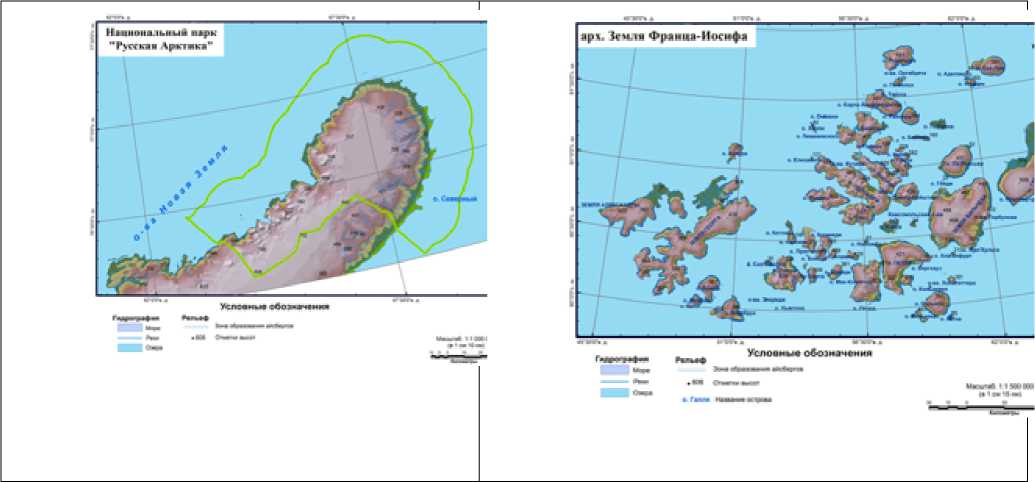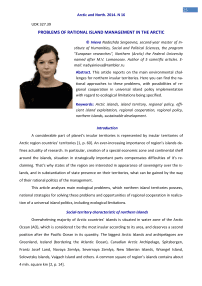Problems of Rational Island Management in the Arctic
Автор: Inieva N.S.
Журнал: Arctic and North @arctic-and-north
Рубрика: Social sciences, economics, management
Статья в выпуске: 16, 2014 года.
Бесплатный доступ
This article reports on the main environmental chal-lenges for northern insular territories. Here you can find the national approaches to these problems, with possibilities of regional cooperation in universal island policy implementation with regard to ecological limitations being specified.
Arctic islands, island territory, regional policy, effi-cient island exploitation, regional cooperation, regional policy, northern islands, sustainable development
Короткий адрес: https://sciup.org/148319826
IDR: 148319826 | УДК: 327.39
Текст научной статьи Problems of Rational Island Management in the Arctic
A considerable part of planet’s insular territories is represented by insular territories of Arctic region countries’ territories [1, p. 60]. An ever--‐increasing importance of region’s islands de--‐ fines actuality of research. In particular, creation of a special economic zone and continental shelf around the islands, situation in strategically important parts compensates difficulties of it's re--‐ claiming. That’s why states of the region are interested in appearance of sovereignty over the is--‐ lands, and in substantiation of state presence on their territories, what can be gained by the way of their rational politics of the management.
This article analyses main ecological problems, which northern island territories possess, national strategies for solving these problems and opportunities of regional cooperation in realiza--‐ tion of a universal island politics, including ecological limitations.
Social--‐territory characteristic of northern islands
Overwhelming majority of Arctic countries’ islands is situated in water zone of the Arctic Ocean (AO), which is considered t be the most insular according to its area, and deserves a second position after the Pacific Ocean in its quantity. The biggest Arctic Islands and archipelagoes are Greenland, Iceland (bordering the Atlantic Ocean), Canadian Arctic Archipelago, Spitsbergen, Frantz Josef Land, Novaya Zemlya, Severnaya Zemlya, New Siberian Islands, Wrangel Island, Solovetsky Islands, Vaigach Island and others. A common square of region’s islands contains about 4 mln. square km [2, p. 14].
As the element of territorial structure of a state, northern islands (except Iceland) are a specific removed periphery as part of one or another country of a region. Because of it they usual--‐ ly don’t enter the main format of order of administrative--‐territorial regulations and can have spe--‐ cial control procedures, as for example Faroe Islands in Denmark or Aland Islands of Finland. Popu--‐ lated islands unite monoorientation of economy, thus extraction, processing and export of sea--‐ food, existence of common problems and development specialties. Preference of a particular ad--‐ ministration approach is usually achieved by presence of these islands as part of a country. Thus, for Russian Federation and USA historically it was usual a war--‐strategic islands’ development. Norway leads a politics of scientific islands’ development, and Denmark islands include great envi--‐ ronmentally protected sites. Canada uses all the approaches and moreover this country is consid--‐ ered to be an initiator of formation of islands’ territories legal confirmation.
With that, a complex of northern island territories appears as a united area while being an object of ecological politics.
Politics of a rational island--‐usage in the Northern countries
For island territories it is characteristic an existence of unique ecosystems, which are char--‐ acterized by being of difficult and fragile interrelations, high--‐scale expansion of endemics, which becomes as a result of its isolation from the continents. In relation to Northern countries the fol--‐ lowing statement is right, that low temperatures of ocean waters and rather poor florula leads there to appearance of ecological crisis.
Some Northern Islands have a special specialization and are used as year--‐round or season--‐ able inhabitation of animals and birds. For example, Wrangel Island represents a singular im--‐ portance for preservation of a white bear population. That’s why many great and small island ter--‐ ritories have a right to be proclaimed as natural areas under special protection with different sta--‐ tus.
Creation of natural areas under special protection in the northern islands will give an op--‐ portunity to save unique natural complexes with all its components. One of the first Natural areas of preferential protection became a national park of Arctic Islands, founded 1926 on the island territories of Canada. It has not only environment--‐oriented importance but it also add to the coun--‐ try’s strength on these territories [3, с. 343]. One of the youngest NAPP is considered to be “Rus--‐ sian Arctic”, founded 2009. It includes northern part of the island of the Northern archipelago No--‐ vaya Zemlya with adjoining islands. In December 2010 FSBO “National park “Russian Arctic” achieved under its supervision the most northern territory of Eurasian land — a state nature re--‐ serve of a federal significance “Franz Joseph Land”, which was founded 1994 1

Pic. 1. URL: ‐; ‐
An entire preservation of an island ecosystem is impossible without a continuous coastal belt, its key element, realizing at first its contact function and connecting an above--‐water and un--‐ derwater portion of the island. Shift of emphasis from overland exploration of northern islands to the shelf one drives the necessity of SPNA by organizing sea reserves in surrounding area. So, 2005 representative of a Norwegian party suggested some environment--‐oriented, which were based on essential expansion of environment--‐oriented regime for 21--‐mile sea zone of Norwegian territory waters, which ring about Spitzbergen archipelago, for account of giving them status of blanket protection. Such measures had an intention to provide comfortable conditions of white bear population inhabitance. The same experiment was earlier realized on the territory of Russian na--‐ ture reserves, on Wrangel Island in particular, when its status was developed for 12--‐mile sea zone of territorial waters around Wrangell and Herald Islands, and 1999 the status of exclusive zone was given to 24--‐mile sea water area around the whole reserve2.
An important element which completes the politics of rational island--‐usage on the North is creation of special Research and Practical Centers, which supply collection and processing of dif--‐ ferent data about island territories. Regional universities, situated on the northern periphery in comparison with universities in state centers are able to affect better on regional economy. As an example for such a research centre we can name universities of Spitsbergen archipelago, Prince Eduard Island (Canada) and summer university of Solovetsky Islands.
As a positive trend we can specify global scientific projects, which are realized on islands. In particular, on Spitsbergen archipelago a project of creation of World Bank of seeds is being real--‐ ized, which is situated at the depth of 120 meters and at the height of 130 meters above sea. Spitsbergen was chosen for such a project because of its permafrost and low tectonic activity in the region of archipelago.
It is also important to pay attention on manufacturing industry in maritime belt, which cross--‐border influence can badly affect ecological situation of island territories.
Cross--‐border relations in island territories’ reclamation
Earlier defined ecological problems as solved, as usual, during “island--‐continent” relations. While the duplication of some ecological challenges define the opportunity of decision proce--‐ dure’s development as part of multilevel international cooperation of such territories. A specialty of such a course will become cooperation based on reference to territories with particular geo--‐ graphical characteristic. The main goal of such coordination is considered to be development of a common strategy of activities in relation to islands. So, on the regional level it is important to de--‐ velop common concepts and mechanisms of economic, social and ecological aspects of politics in the problem of achievement of sustainable development. For achievement of sustainable devel--‐ opment it is important to provide mutually beneficial balance of international and national ecolog--‐ ical priorities.
Such directions of common ecological politics of northern countries concerning islands as decision of utilization problems, landscape degradation, development of common landscape poli--‐ tics, innovation usage in the sphere of water supply, development of conditions for ecological tourism development, creation of a net of Arctic Island reserves and activation of negotiation for demilitarization of northern islands can be prospective. Implementation of special landscape poli--‐ tics on island territories is considered to be important.
To avoid duplication and to reach maximal optimization of projects of economic manage--‐ ment on Arctic island territories it is important that this support will be coordinated through state regional government. On this evidence it is important to create regional working groups and to provide this coordination and also to collect all the important information about these territories. Interdepartmental coordination approach can be created on the level or include working group of specialists who answer for concrete fields. The greatest opportunities for creation of international cooperation under island municipals have autonomous units of Northern Europe countries (Green--‐ land, Farer Islands and Aland Islands), which use the elements of status of international rights’ subjects, taking part in work of international organizations, conferences and so on. Initiative of these island regions can actualize integration in cross--‐border cooperation of other countries’ is--‐ lands.
Also when development of fundamental international contract about Arctic by arctic and another countries is it viable to include a special part in it, which will regulate law and common measures for islands’ and other island territories’ development. Among laws, consisting it, it is worth--‐while emphasizing following:
-
a) About countries’ joining efforts in adaptation of northern countries for climate change;
-
b) About predominance of mostly natural--‐safe and scientific presence on northern countries;
-
c) About reduction of all countries armed forces’ presence on northern islands with future perspectives of their demilitarization;
-
d) About creation of cross--‐border net of reserved territories and securing of system integrality of island SPNA of the region. But when on continents such roles are given for ecological corridors, here the connection of SPNA can be provided by sea current and animals’ way [4, p. 31].
Conclusion
So, realization of rational politics of economic management in northern islands, based on rethinking of methods and approaches according to the principles of sustainable development is considered to be a necessary substantiation of state presence on these territories. As complex of arctic island territories amounts to cross--‐border space, firstly from the point of view of ecological parameters it is homogenous. Supply of such politics’ realization is possible in connection with country’s region’s practice on management of Arctic Islands.
Список литературы Problems of Rational Island Management in the Arctic
- Limarev V.I. Osnovy ostrovovedeniya [Baseline of Island science]. Monograph / edited by B.G.Ermolina. Arkhangelsk, Pomorsky gosudarstvenniy universitet, 2002. 192 p.
- Lukin Y.F. Velikiy peredel Arktiki [Great margin of the Arctic]. Arkhangelsk, NArFU, 2010. 400 p.
- Sivakov D. Vodnoye pravo Rossii i zarubezhnyh gosudarstv [Russian and foreign countries’ water laws]. Litres, 2013. 480 p.
- Ivanov A.N. Sistema osobo ohranyaemyh prirodnyh territoriy na ostrovah severnoy pacifiki [System of nature reserves on islands of Northern Pacific]. Geografiya i prirodniye resursy Geography and natural sciences, 2007, no. 4. pp. 28-‐32.


